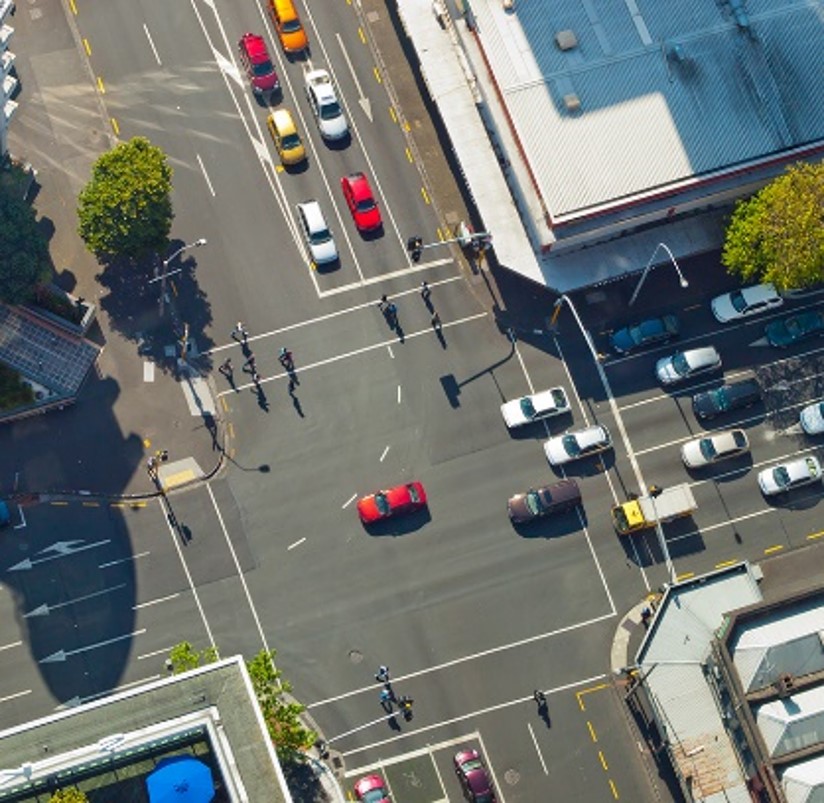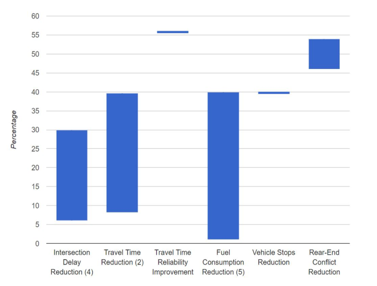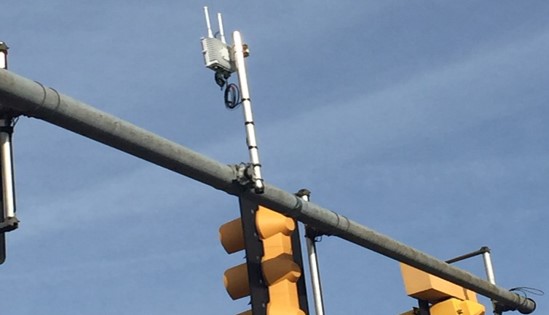2019 Executive Briefing
 BRIEFING HIGHLIGHTS:
BRIEFING HIGHLIGHTS:
- Simulation models indicate intelligent intersections can reduce rear-end conflicts by 46 to 54 percent with only 10 percent connected vehicle market penetration.
- Intersection SPaT data shared with connected vehicles equipped with intelligent cruise control features can smooth speed profiles and reduce fuel consumption up to 40 percent.
Introduction
Recent marketplace interest in connected vehicle technology combined with improved signal control software, traffic detection, wireless communications, and shared database management systems have presented new opportunities to improve operations on arterial networks.
| Improved traffic signal control continues to be one of the most cost-effective ways to improve safety and mobility in most jurisdictions. |
In order to leverage developing technologies, the United States Department of Transportation (USDOT) is working with industry experts to advance several connected vehicle research programs. The Signal Phase and Timing (SPaT) Challenge and the Connected Vehicle (CV) Pilot Deployment program are two ongoing efforts aimed at developing connected vehicle technologies in real-world operational settings where cutting-edge mobile and roadside ITS technologies can be tested and proven.
The SPaT Challenge supports testing of 5.9 GHz Dedicated Short-Range Communications (DSRC) infrastructure and encourages cooperation between equipment manufacturers and state and local Infrastructure Owners and Operators (IOOs) to establish SPaT messaging in at least one corridor in every state by 2020 where wireless connected vehicles operate. Concurrently, the CV-Pilot Program enables field operational testing for a broad range of interconnected ITS applications to assess performance of connected vehicle technology on test tracks and evaluate impacts in live traffic. Both programs are cooperative public-private efforts.

In the future, a significant challenge for partnering agencies will be to achieve consensus on high-level designs for interoperable systems nationwide while accommodating local applications of interest. To promote interoperability, the USDOT works with a variety of international and domestic Standards Development Organizations (SDOs) to support consistent and rigorous development of ITS standards and planning tools that can be used to align industry efforts and accelerate deployment [1]. Overall, these standards and tools are designed to encourage development of sustainable solutions that are independent of individual proprietary products or applications.
Advancements in connected data technology is transforming traffic signal control systems in terms of traffic signal controller logic, operations, and performance. When connected vehicles and intersection signal controllers are fully networked and equipped with two-way communications it will become possible to optimize the efficiency of both systems while improving performance across the transportation network. Where traffic signal controllers and Roadside Units (RSUs) are able to exchange SPaT and MAP messages with approaching vehicles, these vehicles will be able to adjust movements while communicating geo-referencing data to centralized traffic management stations so controller logic can be adjusted in real-time to improve safety and mobility. Where rapid information exchange is required as needed for intersection safety applications, large scale field tests have shown that DSRC technology can meet low latency requirements. Although cellular V2X (vehicle-to-everything) and 5G technologies are considered viable alternatives, field testing is still underway to verify that these technologies can meet specifications required for advanced traffic signal control, multi-modal priority, and network surveillance applications.
Benefits

One of the most compelling opportunities presented by connected vehicles is to communicate with infrastructure. Across an urban network, connected vehicle data can be collected by traffic management systems to optimize overall network performance and improve safety. Findings from several field operational tests and simulation efforts are highlighted in Figure 2.
The online versions of the executive briefing feature interactive graphs that contain all the data points included in the ranges. Here, each metric has a number after the text, representing the number of data points used to create the range; no number means only there was only one data point.
Costs
RSU DSRC infrastructure deployment costs can range from $13,000 to $21,000 per site, with average costs estimated at $17,600 (2014-00325). Estimated annual DSRC site operations, maintenance and replacement costs can range from $1,950 to $3,050 (2014-00329). Costs for backhaul telecommunications used to support a RSU for vehicle-to-infrastructure (V2I) applications can vary from $3,000, if the site has sufficient backhaul and will only need upgrades, to $40,000 if the site requires a completely new backhaul system (2017-00376).
Best Practices
| V2I Hub Deployment Guide provides agencies a roadmap through the pre-deployment and post-deployment process to supplement existing agency procedures. |
As the USDOT encourages state and local entities to deploy connected vehicle technology under their jurisdiction, the V2I Hub Deployment Guide was created to provide an outline with step-by-step instructions for deploying V2I Hub software and hardware [2]. This deployment guide outlines a phased approach and provides insight into needs analysis, planning, design, procurement, field deployment, and post deployment issues (2018-00838).

As part of the Dynamic Mobility Applications (DMA) program USDOT supports development of Multi-Modal Intelligent Traffic Signal Systems (MMITSS). MMITSS are the next generation of traffic signal systems that seek to provide a comprehensive traffic information framework to serve all modes of transportation, including general vehicles, transit, emergency vehicles, freight fleets, pedestrians, and bicyclists in a connected vehicle ecosystem. MMITSS applications such as Intelligent Traffic Signal Systems (I-SIG) use vehicle location and movement information from connected vehicles as well as infrastructure measurement of non-equipped vehicles to improve intersection signal control operations (2015-01052).
| Field testing suggests MMITSS can reduce average delay up to 13.6 percent for both equipped and non-equipped vehicles, and improve travel time reliability by 56 percent. |
Use cases drawn from MMITSS projects have been included in the ISO (International Organization for Standardization) Standard 19091 to support V2I systems development.
Case Study
Georgia DOT Operational SPaT Deployments

As part the nationwide SPaT Challenge, the Georgia DOT (GDOT) implemented a two phase project to improve safety, mobility, freight, and partnerships in the Atlanta metropolitan area (2018-00409). The project included development of back-end infrastructure, network components, and business processes to support broad vehicle-to-infrastructure applications.
Phase 1 of the project used DSRC to exchange SPaT and MAP messages between intersection systems, connected vehicles, and pedestrians with connected devices to support the following applications:
- Red light warning. Safety for drivers – alerts of inability to safely clear an intersection
- Pedestrian in crosswalk. Safety for drivers and pedestrians – turning vehicles have additional awareness of other users
- Phase service remaining. Efficiency for drivers – alerts drivers for safe intersection passage or efficient stopping
- Green speed for coordinated signals. Efficiency for drivers – informs drivers of optimal driving speeds through coordinated signals to minimize stops.
Phase 2 of the project planned through June 2020 is expected to include connections at 1,700 traffic signals, integrate ramp metering, and disseminate roadway and traffic information to third parties via an Open Data Stream.
RSUs and OBUs (on-board units) were identified as major cost drivers for the project.
| DEPLOYMENT ESTIMATE | FY 2019 (600 RSUs) | FY 2020 (1,100 RSUs) |
|---|---|---|
| RSU Equipment | $780,000 | $1,430,000 |
| RSU Deployment | $510,000 | $935,000 |
| RSU Configuration & Support | $1,200,000 | $2,200,000 |
| TOTAL | $2,490,000 | $4,565,000 |
- 1,700 Roadside units at $1,300 per device.
- RSU deployment at $850 per location.
- RSU configuration at $2,000 per device.
- OBU costs at $1,000 per device (optional).
Additional evaluation and technical performance data will likely become available as the system continues to be tested and transitions to operations.
References
- "ITS Standards Program." ITS Joint Program Office Website, https://www.standards.its.dot.gov/.
- V2I Hub Guidebook. USDOT FHWA, March 2018. https://www.itsforge.net/data/repo/docs/V2I_Hub_Guidebook.pdf.

